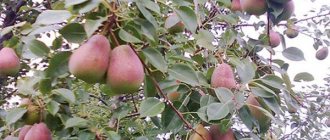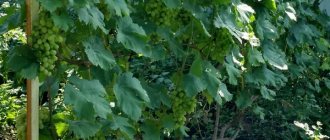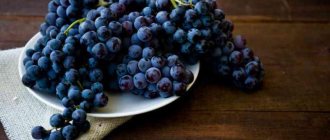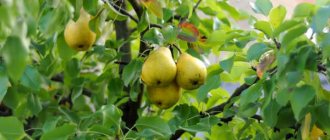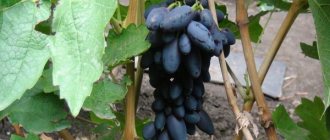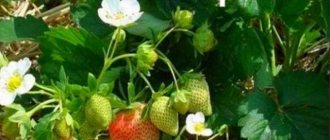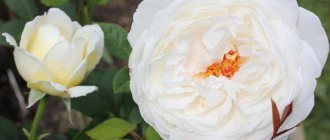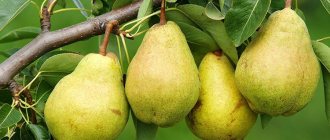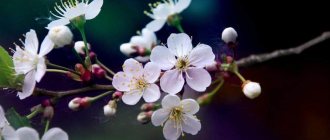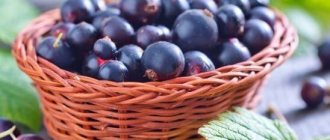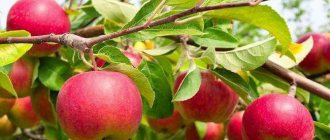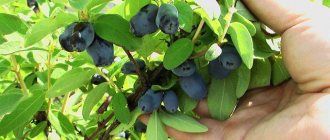Gardening » Pear
0
1136
Article rating
Kira Stoletova
The trout pear dates back decades and is widely grown in China, the USA and Latin America. Today its fruits are considered the most beautiful and fragrant, and the variety does not lose its popularity at all. A detailed description of the Trout pear variety is presented in the article.
Description of trout pear
Description of the variety
The Trout pear variety is a guest from the American continent; it has not yet become widespread in Russia. It is quite possible that this is due to the capriciousness of the tree. The variety is productive, with elegant, tasty fruits, but it is difficult to take root and often gets sick.
Characteristics of wood
The Trout variety tree is medium-sized, growing up to 5 meters. The crown is round, spreading, the branches are thin and directed upward. The foliage is small in size, dark green in color, elongated.
Description of fruits
Pear Trout.
Trout pear fruits look remarkable to say the least. They are bright, visible and very beautiful.
Their hue is yellow, the blush is deep red, gradually spreading over the entire area. The fruit is medium in size, regular in shape.
The taste of the fruit is very high. The trout are juicy, with a sweet but not cloying pear flavor and a slight hint of cinnamon. The aroma combines all these notes as well.
How to plant and care properly
Clapp's favorite pear
When selecting pear seedlings, preference should be given to annual planting material. The tree should be selected based on the condition of the branches; they should not have visible deformations. Applying weak force results in bending, not breaking, of the branches. A normal root is 70 centimeters long.
Note: when selecting a location, remember that the seedling needs plenty of sunlight.
It is not recommended to plant a pear on a flat area due to constant blowing from all sides - seedlings of the Trout variety do not react well to the influence of strong winds. It is recommended to place the pear tree on the south or southeast side of the garden plot.
Planting a pear
When forming a garden, you should take into account the size of the crown of the future tree. To avoid a close fit of the pear tree to the neighboring planting, the minimum distance when planting a pear in relation to neighboring trees is four meters.
How to plant a seedling correctly
During autumn digging, the soil should be fertilized using organic compounds. To fertilize 1 m2 of plot area, you will need droppings or manure (3 kilograms), compost (about 4 kilograms), and ash (1 kilogram).
Preparing a place for planting a seedling
It is recommended to dig a planting hole for planting pear seedlings in the autumn season - the depth is one meter, the diameter is 85 centimeters. The fertile layer of soil taken from above should be placed separately. It is best to carry out preparatory activities when the leaves fall, but they must be completed in time for the first frost.
Work to prepare the planting hole in the spring season is as follows:
- two weeks before planting, a depression of the required size is created, into which sand and humus should be added in the amount of two buckets, superphosphate (1 cup) and potassium sulfate (3 tablespoons);
- lime should be diluted in a 10-liter bucket, after which the solution should be poured into the hole.
Important! The place to keep seedlings before planting should be cool and shaded. All cuts must be treated using garden varnish. Next, the prepared seedling is placed in a bucket of water for at least an hour.
Sequence of actions during disembarkation:
- The fertile layer of soil and ash are mixed with water. The root system of a pear seedling is placed in this mixture.
- At the bottom of the planting recess, a drainage layer is laid out in the form of small stones, small branches and pebbles. A certain amount of fertile soil should be poured on top of the drainage layer; it should form a small hill.
- Place the tree in the hole and straighten the roots. Initially, the recess is filled with an enriched composition, then with an ordinary one.
- When ⅔ of the hole is filled, fill it with a bucket of water. After waiting for the soil in the hole to dry, you can finally fill the hole with the remaining soil.
How to form a crown correctly
It takes 6 years for the crown of a pear tree to fully grow. By this age, trees have five main branches. In early July, the lower tier should be formed by selecting 3 strong branches located at 20-centimeter intervals relative to each other.
Pear pruning
When pruning, you should maintain the location of the central branch 20 centimeters above the rest of the branches:
- carrying out sanitary pruning involves removing weakened shoots, the growth of which is directed inside the crown;
- in the third year, the crown is formed - all branches, with the exception of the main ones, are shortened by ⅔;
- in the fourth and fifth years, the lateral and secondary branches growing upward are removed.
Signs of a finally formed crown are a clear definition of the main branches, the absence of large parallel and cross branches. The general appearance of the tree is proportionate.
Watering and fertilizing
In summer, settled water heated by the sun is used to water the seedling. To settle the soil, abundant watering is necessary.
Watering pears
In the second year, the Farel pear is watered twice a month. Upon completion of watering, the soil must be loosened, weeded and mulched. Straw, sawdust and mown grass are placed in the area of the tree trunk circle. The mulch layer should be 5 centimeters.
Note: you can fertilize the planting for the first time in the second year. For spring fertilization, the application of urea is suitable. When entering the fruit set phase, nitroammophoska is usually used.
Autumn fertilizer consists of superphosphate and potassium chloride. Also, by digging up the area around the trunk, you can additionally add wood ash.
Reviews
Varvara
Yalta
I have been growing trout pears for 10 years. He's problematic, to say the least. Often during flowering it becomes covered with burns, because of this I almost lost my entire harvest a couple of times.
Alexander Petrovich
Ufa
Like a new pear, I have another stress, but I can’t stop with my experiments. I fell in love with Trout very much, so much so that I am ready to endure her whims.
Taisiya
Makhrovo
Trout pear is one of our favorites; we buy it at the supermarket. And when planting the garden, I decided to plant it. The tree is still only 3 years old, but every year I carefully cover and protect the pear.
Planting and caring for Rogneda pear
It is better to purchase seedlings from trusted suppliers or nurseries. A young tree should have a well-developed root system and a healthy trunk with a diameter of at least 1.5 cm, without mechanical damage. Plants with a closed root system can be planted in spring, summer or autumn. Pear seedlings with bare roots take longer to adapt to a new location, so they can be planted in the spring, before the leaves bloom, and in the fall, a month before the onset of cold weather.
A seedling of the Rogneda pear variety is purchased at 2 years of age; before purchasing, you must read the description of the variety and view the photo.
Landing
Planting Trout pears requires the right approach and taking into account a number of features. It is whimsical regarding the right place and soil, and also requires strict adherence to technology. All these steps are described in more detail in the articles linked below.
How to plant a pear tree correctly
At what distance to plant pears?
How to choose pear seedlings
How to replant a pear
Characteristics of the tree and fruits
The Trout pear tree reaches medium height (5–6 m). The crown is spreading, formed from many thin, upward-pointing branches. The trunk and shoots are gray-brown, the bark is smooth, without bulges or roughness. The leaves are shiny, dark green, with a glossy surface and smooth edges.
The fruits are not very large (120–150 g), but beautiful, smooth, have a regular pear shape and a short, slightly inclined stalk. The skin is smooth and very thin, for which the variety is highly valued. In summer it is green, as it ripens it turns yellow and becomes covered on one side with a carmine blush. A fully ripened fruit has a golden-yellow skin, completely covered with red specks that look like freckles.
But a beautiful presentation is not the only advantage of a pear. Its white, fine-grained pulp also has an exceptional taste - when fully ripe, it is sweet, with slight sourness and a slight aftertaste of cinnamon.
Care
Pear Trout is whimsical and capricious, you have to admit it. Only thanks to correct and timely agricultural technology can the Forrrell variety be successfully grown.
This includes treatment of the crown from pests and diseases, its thinning and formation. It is also necessary to water and feed the tree in a timely manner, and carry out loosening. Each step is described in detail in the articles linked below.
How to care for a pear Pruning a pear Pruning a columnar pear Treating a pear from diseases and pests Feeding a pear How to water a pear
Calorie content Pear "Trout". Chemical composition and nutritional value.
Nutritional value and chemical composition of “Trout Pear”.
The table shows the nutritional content (calories, proteins, fats, carbohydrates, vitamins and minerals) per 100 grams of edible portion.
| Nutrient | Quantity | Norm** | % of the norm in 100 g | % of the norm in 100 kcal | 100% normal |
| Calorie content | 42 kcal | 1684 kcal | 2.5% | 6% | 4010 g |
| Squirrels | 0.4 g | 76 g | 0.5% | 1.2% | 19000 g |
| Fats | 0.1 g | 56 g | 0.2% | 0.5% | 56000 g |
| Carbohydrates | 11.4 g | 219 g | 5.2% | 12.4% | 1921 |
| Organic acids | 0.5 g | ~ | |||
| Alimentary fiber | 3.1 g | 20 g | 15.5% | 36.9% | 645 g |
| Water | 85 g | 2273 g | 3.7% | 8.8% | 2674 g |
| Ash | 0.7 g | ~ | |||
| Vitamins | |||||
| Vitamin A, RE | 2 mcg | 900 mcg | 0.2% | 0.5% | 45000 g |
| beta carotene | 0.01 mg | 5 mg | 0.2% | 0.5% | 50000 g |
| Vitamin B1, thiamine | 0.02 mg | 1.5 mg | 1.3% | 3.1% | 7500 g |
| Vitamin B2, riboflavin | 0.29 mg | 1.8 mg | 16.1% | 38.3% | 621 g |
| Vitamin B5, pantothenic | 0.05 mg | 5 mg | 1% | 2.4% | 10000 g |
| Vitamin B6, pyridoxine | 0.03 mg | 2 mg | 1.5% | 3.6% | 6667 g |
| Vitamin B9, folates | 2 mcg | 400 mcg | 0.5% | 1.2% | 20000 g |
| Vitamin C, ascorbic acid | 7.65 mg | 90 mg | 8.5% | 20.2% | 1176 g |
| Vitamin E, alpha tocopherol, TE | 0.4 mg | 15 mg | 2.7% | 6.4% | 3750 g |
| Vitamin H, biotin | 0.1 mcg | 50 mcg | 0.2% | 0.5% | 50000 g |
| Vitamin K, phylloquinone | 4.5 mcg | 120 mcg | 3.8% | 9% | 2667 g |
| Vitamin RR, NE | 0.2 mg | 20 mg | 1% | 2.4% | 10000 g |
| Niacin | 0.1 mg | ~ | |||
| Macronutrients | |||||
| Potassium, K | 155 mg | 2500 mg | 6.2% | 14.8% | 1613 g |
| Calcium, Ca | 16.02 mg | 1000 mg | 1.6% | 3.8% | 6242 g |
| Silicon, Si | 6 mg | 30 mg | 20% | 47.6% | 500 g |
| Magnesium, Mg | 12 mg | 400 mg | 3% | 7.1% | 3333 g |
| Sodium, Na | 14 mg | 1300 mg | 1.1% | 2.6% | 9286 g |
| Sera, S | 6 mg | 1000 mg | 0.6% | 1.4% | 16667 g |
| Phosphorus, P | 16 mg | 800 mg | 2% | 4.8% | 5000 g |
| Chlorine, Cl | 1 mg | 2300 mg | 230000 g | ||
| Microelements | |||||
| Bor, B | 130 mcg | ~ | |||
| Vanadium, V | 5 mcg | ~ | |||
| Iron, Fe | 2.3 mg | 18 mg | 12.8% | 30.5% | 783 g |
| Yod, I | 1 mcg | 150 mcg | 0.7% | 1.7% | 15000 g |
| Cobalt, Co | 10 mcg | 10 mcg | 100% | 238.1% | 100 g |
| Manganese, Mn | 0.07 mg | 2 mg | 3.5% | 8.3% | 2857 g |
| Copper, Cu | 0.15 mcg | 1000 mcg | 666667 g | ||
| Molybdenum, Mo | 5 mcg | 70 mcg | 7.1% | 16.9% | 1400 g |
| Nickel, Ni | 17 mcg | ~ | |||
| Rubidium, Rb | 44 mcg | ~ | |||
| Selenium, Se | 0.1 mcg | 55 mcg | 0.2% | 0.5% | 55000 g |
| Fluorine, F | 10 mcg | 4000 mcg | 0.3% | 0.7% | 40000 g |
| Zinc, Zn | 0.19 mg | 12 mg | 1.6% | 3.8% | 6316 g |
| Digestible carbohydrates | |||||
| Starch and dextrins | 0.5 g | ~ | |||
| Mono- and disaccharides (sugars) | 9.8 g | max 100 g | |||
| Glucose (dextrose) | 1.8 g | ~ | |||
| Sucrose | 2 g | ~ | |||
| Fructose | 5.2 g | ~ | |||
| Essential amino acids | 0.167 g | ~ | |||
| Arginine* | 0.021 g | ~ | |||
| Valin | 0.025 g | ~ | |||
| Histidine* | 0.009 g | ~ | |||
| Isoleucine | 0.025 g | ~ | |||
| Leucine | 0.023 g | ~ | |||
| Lysine | 0.025 g | ~ | |||
| Methionine | 0.005 g | ~ | |||
| Methionine + Cysteine | 0.01 g | ~ | |||
| Threonine | 0.028 g | ~ | |||
| Tryptophan | 0.005 g | ~ | |||
| Phenylalanine | 0.031 g | ~ | |||
| Phenylalanine+Tyrosine | 0.04 g | ~ | |||
| Nonessential amino acids | 0.257 g | ~ | |||
| Alanin | 0.014 g | ~ | |||
| Aspartic acid | 0.14 g | ~ | |||
| Glycine | 0.008 g | ~ | |||
| Glutamic acid | 0.027 g | ~ | |||
| Proline | 0.007 g | ~ | |||
| Serin | 0.016 g | ~ | |||
| Tyrosine | 0.012 g | ~ | |||
| Cysteine | 0.003 g | ~ |
The energy value of Trout Pear is 42 kcal.
Primary Source: Created in the application by the user. Read more.
** This table shows the average levels of vitamins and minerals for an adult. If you want to know the norms taking into account your gender, age and other factors, then use the “My Healthy Diet” application.
Diseases and pests
Pear trout in Russia suffers from pests and diseases. This especially applies to aphids and fruit rot. Proper care will help maintain health. But in the event that a tree becomes ill, it is necessary to quickly take decisive action. You can read about protective measures, prevention and treatment using the links to the articles below.
Dangerous Pear Pests
Pears often suffer from pests, they affect the leaves, bark and fruits.
In this article, we have selected 11 of the most harmful insects that harm pear trees, and also ways to destroy them.
Diseases of pear trees
To get what they cherish, gardeners have to work hard, and the reason for this is pear diseases.
Read about 19 common pear diseases and how to combat them.
History of selection and region of breeding
Trout pear is widely known among gardeners around the world; this plant is the main fruit variety grown in the USA, Europe, Latin America and even Australia. Despite universal love and popularity among lovers of fragrant fruits, reliable data about the history of this plant does not exist. The first mentions of it are found relatively recently; a detailed description of the pear and its fruits was published only in 1979, thanks to breeders and fruit lovers from Saxony (Germany). Many private and amateur farms became interested in the plant, after which the pear gained worldwide popularity in just a few decades.
It is believed that the hybrid is quite impressive in age; its ancestors grew in East Germany for many centuries and were a traditional type of local vegetation. Subsequently, they were crossed with many more exotic varieties migrating from other parts of the world during the Great Geographical Discoveries. As a result of this, a special pear appeared, distinguished by its unique fruits. However, this statement is only an assumption that is not supported by solid evidence. Despite this, the plant is considered to be the heir of the ancient Saxon fruit species.
Where does the variety come from?
Today, the Trout pear, the original name Forella, is known in many countries around the world.
A number of scientists are of the opinion that the variety was first bred in America. There are sources that claim that the species was first described in 1979, in Saxony, now Germany, and the producing country is South Africa (China). Pear production can also be traced in Argentina, South America, Washington, and Oregon. A large number of harvests can be traced to the Goulburn Valley, Australia.
When comparing pear with other varieties, it is important to note that this type produces color earlier than others. Pollination occurs thanks to bees.
This is necessary in order for the fruits to set correctly so that they are of the correct shape. The symmetry of fruit development depends on the uniform arrangement of seeds. It is recommended to thin out the formed and established buds.
Where does trout pear grow?
The Trout variety is grown in Latin America (Chile, Argentina) and the USA (Oregon, Washington). The culture is popular among Australian farmers. On store shelves you can find the fruits of a hybrid produced in South Africa. Large areas for gardens where Forella is cultivated are allocated in China.
General recommendations for growing
It is recommended to regularly prune pear trees so that ultraviolet light reaches the fruits during formation and ripening. The sun's rays will help maintain the desired glow during harvesting, since the difference in day and night temperatures is not enough for this. When the fruits are picked unripe, they are ripened. then the blush will be weak and small in area.
Trout need bees to pollinate
Trees are often infected with scab and are sensitive to bacterial burns and bacteriosis, especially during flowering. Also, the variety is very fond of aphids, so it is recommended to spray the apical shoots with an ash decoction. It is recommended to collect fruits in mid-September. Then the fruits are green and can ripen indoors.
If you collect ripe fruits, then this should be done at the end of September.
Trout is affected by aphids - treatment is needed
If you store fruit indoors for fifteen days, then the air temperature should be from 0 to 3; when storing for a period of one month, the air temperature should be no higher than 5 degrees. Trees do not tolerate transplantation to another soil or to another place; it is important to initially choose the right place for planting seedlings; it is recommended that the soil be warm and well heated. The variety bears fruit well; the first harvest can be harvested from the second year of the tree’s life.
Watering and fertilizing the soil
In summer, it is recommended to water the seedling with warm water. Moreover, it is necessary to literally flood the Trout variety so that the soil settles and the soil is well saturated.
Starting from the second year, watering the pear is carried out once or twice a month. After watering, be sure to loosen the soil, weed and mulch. You can put straw, sawdust, and mown grass inside the tree trunk circle. A sufficient layer of mulch is approximately 4-6 cm.
Advice! Fertilizers should be applied from the second season. In spring you can use urea. During the period of fruit set, Trout is fed with nitroammophoska.
In the autumn, superphosphate and potassium chloride are added. It also doesn’t hurt to add wood ash to the soil when digging around the tree trunk.
Preparation
If a landing site is chosen, it must be prepared. With the arrival of autumn, organic fertilizers are added while digging the soil. Usually they use familiar substances.
- A kilogram of ash per square meter of planting. This fertilizer cannot be used often. A break of 3-4 years is needed.
- Manure or bird droppings at a rate of 3.5 kilograms per “square” gives a good result. In winter, the components will ferment and thoroughly saturate the soil. The work is carried out at intervals of 2-3 years.
- Some gardeners use compost, adhering to the above volumes.
If a landing site is chosen, it must be prepared. With the arrival of autumn, organic fertilizers are added while digging the soil. Usually they use familiar substances.
- A kilogram of ash per square meter of planting. This fertilizer cannot be used often. A break of 3-4 years is needed.
- Manure or bird droppings at a rate of 3.5 kilograms per “square” gives a good result. In winter, the components will ferment and thoroughly saturate the soil. The work is carried out at intervals of 2-3 years.
- Some gardeners use compost, adhering to the above volumes.
